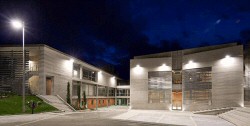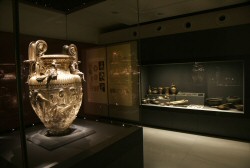Conference Venue
- The
Museum of Byzantine Culture was chosen as the main venue for the conference for a
number of reasons. First, it is considered to be the best museum of Byzantine
and Post-Byzantine art internationally known. Second, it is located downtown,
close to the most important sites of the city. Third, it is within walking
distance from the majority of city hotels. And finally, it has very interesting
exhibits and warm amphitheatres.
The Museum of Byzantine Culture aims in presenting various aspects of life
during the byzantine and post-byzantine periods: art, ideology, social
structure and religion, as well as how historical changes and the political
situation were affecting people' s everyday life. It was awarded the Council
of Europe Museum Prize for 2005, following the concurrent recommendation of
the Council' s Committee for Culture, Science and Education.
The founding of the Museum of Byzantine Culture and its official opening in
1994 in Thessaloniki, the most "Byzantine" city of the modern Greek state,
marks the end of a story that had begun long before, just after the city' s
liberation in 1912.



- The City Hall is our second venue and is located next to the Byzantine Museum.
It is a new building with a very interesting modernist design.



- The
Archaeological
Museum of Thessaloniki (AMTH) occupies a distinct place at Greeceís
cultural map. It is the largest museum in Northern Greece and one of the most
important nationwide. Its collections cover all chronological periods from
prehistory to late antiquity and derive from all over Northern Greece. Its main
collections focus respectively on ceramics and mosaics, sculpture and miniature
art and metalworking. In 2003 it was completely renovated in order to meet new
technical and museological advances. The new exhibition of antiquities was
organised into six permanent thematic units - Prehistoric Macedonia. Towards
the birth of cities. Macedonia from the 7th c. BC until late antiquity.
Thessaloniki, Metropolis of Macedonia. The gold of Macedon, that encompass
all aspects of private and public life in antiquity, and finally Field House
Garden Grave, the Museumís exhibition in the open courtyard. Recently the
museum was enriched by a unique exhibition of pioneering interactive systems
regarding ancient Macedonia, entitled Macedonia from fragments to pixels.
Since 2012, the AMTH has organized various temporary exhibitions in
collaboration with many national and international organizations and institutes.



For information about the city of Thessaloniki please visit:
http://www.saloniki.org/,
http://www.thessaloniki360.com/en/








